- Department of Public Health, College of Health Sciences, Salale University, Fiche, Ethiopia
Background: The utilization of an immediate postpartum intrauterine device (IPPIUD) during the postpartum period helps women to realize their desire for birth spacing and prevent unplanned pregnancies. However, many postpartum mothers do not undergo immediate postpartum family planning in developing countries, including Ethiopia, which consequently increases the risk of unplanned pregnancies and pregnancy-related complications.
Objective: To assess the utilization of an IPPIUD and its associated factors among women who gave birth in public hospitals in the West Wollega Zone in 2022.
Methods: An institutional-based cross-sectional study was conducted among 605 postpartum mothers who delivered their baby between 15 April and 15 May 2022 at public hospitals in the West Wollega Zone, Ethiopia. A systematic random sampling technique was used to select study subjects, and the data were collected using an interviewer-administered structured questionnaire, which was then entered into EpiData Entry version 4.6 and exported to the Statistical Package for Social Science version 26 for analysis. The variable with a p-value of ≤ 0.05 with an adjusted odds ratio and 95% confidence intervals was used to declare statistically significant association.
Result: The prevalence of the utilization of the IPPIUD among respondents who gave birth in West Wollega public hospitals within 48 h was 27.2% (95% CI, 23.7–30.9). Age ranging between 25 and 34 years (AOR = 4.27, 95%CI:1.68–10.85), early initiation of antenatal care (ANC; AOR = 1.91, 95%CI: 2.8–10.01), adequate knowledge of IPPIUD (AOR = 4.71, 95%CI: 2.63–6.63), favorable attitude toward family planning (AOR = 3.35, 95%CI: 2.07–5.44), planning of pregnancy (AOR = 2.21, 95%CI: 1.37–4.11), and counseling (AOR = 4.14, 95%CI: 2.60–6.68) were factors that were significantly associated with the utilization of IPPIUD.
Conclusion: According to the 2019 Ethiopia Mini Demographic and Health Survey (mini EDHS 2019), the utilization of an immediate postpartum intrauterine device was low, that is, 35%. Age of respondents, early initiation of antenatal care, favorable attitude toward, planning of pregnancy, adequate knowledge of, and counseling on IPPIUD utilization were significantly associated with the mother’s utilization of immediate postpartum intrauterine device. Thus, the zonal health office and health professionals should work toward encouraging all the women who gave birth at public hospitals to the utilization of immediate postpartum intrauterine devices by improving awareness among the women in that specific zone through counseling to increase the uptake of IPPIUD.
Introduction
An immediate postpartum intrauterine device (IPPIUD) is a postpartum contraceptive inserted into a woman’s uterus after delivery of the placenta. It is made up of plastic copper intrauterine device type T380A (CU T-380A) and can be classified into post-placental, immediate postpartum, early postpartum, and extended postpartum intrauterine devices that are inserted within 10 min, 48 h, 48 h to 6 weeks, and 6 weeks to 1 year after birth, respectively (1–3). Postpartum family planning helps women to realize their desire for birth spacing and prevents them from having unplanned and closely spaced pregnancies throughout the first 12 months following childbirth (4). The immediate postpartum intrauterine device (IPPIUD) is safe and effective, with a low expulsion rate when compared to the interval intrauterine devices that are used to avoid unwanted pregnancies (5, 6), and is a highly convenient option for postpartum mothers who want a long-acting, reversible, non-hormonal protection from pregnancy that can be initiated during the critical postpartum period (7, 8).
Globally, in 2020, among the 1.9 billion women of reproductive age group, 57.19% of them had the desire to use family planning, 17% of them had utilized intrauterine devices, and 10% of did not use any contraceptive method (3, 9), and in Eastern and South-Eastern Asia, 18.6% of women utilized IPPIUD in order to avoid pregnancy (10). Family planning (FP) is recognized as a key life-saving intervention for mothers and their children (11), and the IPPIUD can promote the health of women and children by preventing unwanted pregnancies and financial, psychological, obstetric, and other health and health-related complications associated with closely spaced pregnancies, and its insertion does not require repeated healthcare visits for contraceptive refills (12–15).
In Africa, the utilization of IPPIUD is still low; the percentage of mothers who used an immediate postpartum intrauterine device within 48 h of placenta delivery was 4, 3.4, 1.1, and 0.3% in Rwanda, Zambia, Kenya, and Eretria, respectively (10, 16). In Ethiopia, the utilization of IPPIUD remains very low beside the high level of unmet need for postpartum family planning (3), and the report of the Maternal and Child Survival Program (MCSP) project showed that 8.55% of mothers had utilized an immediate postpartum intrauterine device within 48 h of delivery (4). A study conducted in the Bale Zone and the EngenderHealth report of the project of western Oromia revealed that the immediate postpartum intrauterine device was utilized by 12.4 and 8% of women, respectively (9, 17). Immediate postpartum is a critical period for the uptake of family planning to prevent unwanted pregnancy (18). However, given the high emphasis on contraceptive use, contraceptive use by mothers during this period is low (5, 6, 19).
Ethiopia has introduced IPPIUD initiatives to increase access to postpartum family planning and strengthen service provision, responding to women’s high unmet need for postpartum family planning (18). The Maternal and Child Survival Program (MCSP) initiated and introduced the postpartum family planning program in Ethiopia (18, 20), continued to extend its support to increase the availability of long-acting family planning and scale-up postpartum family planning (PPFP) at the national and facility levels, integrated IPPIUD services into national and reproductive health policies, trained maternity staff on its insertion and on counseling the mothers, provided on-site mentorship of newly trained healthcare providers, engaged experts in the fields, and advocated its benefits to policymakers (5, 21–23).
Previous studies have reported that the utilization of IPPIUD is significantly associated with sociodemographic characteristics such as age, marital status, educational status, occupation, and residential area and reproductive characteristics such as age at marriage, age at first delivery, number of pregnancies and births, number of antenatal care (ANC) follow-ups, and number of alive children (1, 5, 6, 19, 24, 25). However, notable actions were not taken at the household, community, and facility levels to maximize the possibility of making couples aware of all possible postpartum family planning options available to them, including immediate postpartum intrauterine device, to improve poor communication or a lack of communication between couples, and to encourage women to engage their male partners in postpartum family planning decisions (18, 25). Postpartum women are among those with the greatest unmet need for postpartum family planning (26), and however, they often do not receive the services they need to realize their desire for spacing births and reduce unwanted pregnancy and its consequences (27–29).
Moreover, there is limited evidence and information regarding immediate postpartum intrauterine device utilization, and studies conducted in Ethiopia did not address factors that were important in other African countries such as the number of ANC visits and pregnancy intervals of more than 2 years (29, 30). In general, the primary goal of this study was to provide current information related to IPPIUD utilization in the West Wollega Zone area for mothers, the community, and healthcare providers. Thus, the study was aimed to assess the utilization of immediate postpartum intrauterine device and the factors that affect the utilization of IPPIUD during the postpartum period for the use of IPPIUD among mothers who gave birth in public hospitals in West Wollega Zone, Oromia, Ethiopia.
Materials and methods
Study design, period, and area
The study design was an institution-based cross-sectional design and was conducted among women who gave birth at any one of the five public hospitals in the West Wollega Zone from 15 April to 15 May 2022. The West Wollega Zone is one of the 21 zones of the Oromia National Regional State, and Gimbi Town is the zonal capital city, which is located at a distance of 441 km to the west of Addis Ababa (Figure 1). Based on the 2007 census conducted by the Central Statistical Agency of Ethiopia (CSA), this zone has a total population of approximately 1,741,567 (men = 877,290, women = 864,277) individuals and a total land area of 1,274,501 ha (24). Different governmental and non-governmental health institutions are providing healthcare services for the community, including 5 public hospitals, 2 private hospitals, 67 health centers, 488 health posts, 2 specialty clinics, 22 medium clinics, 212 primary clinics, as well as different private clinics, and drug stores.

Figure 1. Study area map for the study of the immediate postpartum intrauterine device utilization and its associated factors among women who gave birth in hospitals in the West Wollega Zone, Oromia, Ethiopia, 2022.
The total number of health professionals in the zone is 2,806, among whom there are 60 physicians, 147 health officers, 612 nurses, 257 midwives, 387 pharmacy professionals, 223 laboratory professionals, and 1,120 other professions, including health extension workers (24). The average number of mothers who gave birth in all study area hospitals by both spontaneous vaginal delivery (SVD) and cesarean section (CS) in the previous 3 months before the start of the study were identified as follows: 368 in Gimbi General Hospital, 302 in Najo General Hospital, 250 in Mendi Primary Hospital, 184 in Begi Primary Hospital, and 174 in Bube Primary Hospital.
Generally, major services provided at all hospitals related to Maternal and Child Health (MCH) services are family planning, ANC, and delivery services, and all public hospitals provide these services for free. In addition, all modern contraceptive techniques such as long-acting contraception such as IUCD are available in all hospitals (Source: West Wollega Health Office).
Source population and study population
All women who gave birth in public hospitals in the West Wollega Zone were the source population, and the selected women who gave birth in public hospitals in the West Wollega Zone during the study period were the study population.
Eligibility criteria
Women who gave birth in public hospitals in the West Wollega Zone during the study period and those who fulfilled the eligibility criteria for IUCDs were included in the study. Women who were sick, unable to respond, who had active sexually transmitted diseases, who had ruptured membranes for more than 24 h, who had a ruptured uterus, unresolved postpartum hemorrhage, or uterine tony, and who met the following WHO exclusion criteria were excluded from the study. The exclusion criteria also included those women who showed evidence of puerperal infections such as temperatures (T) >38°C and pulse rates (PR) >100 beats per minute, who were clinically unstable at the time of birth, who had a history of complications during the intrapartum period, who had allergies to the metals used in the CU T380A IUCD, who had stage 4 HIV/AIDS without ARV therapy, and who had opted out following enrolment.
Sample size determination
The sample size was calculated by using Epi Info version 7.2.5 and Stat Calc software programs and determined by using the single population proportion formula with the assumptions of the proportion of women who utilized IPPIUD from the previous study, which was 35.6% (p = 0.356) (31), with a 95% confidence level (CL) of 1.96, a margin of error of 4%, and a 10% non-response rate.
Also, the sample size was calculated for the second objective by using EPI-Info version 7.2 and Stat Calc software programs using the double population proportions formula by considering various factors that were significantly associated with the outcome variables using the following assumptions of a 95% CL and 80% power, where a one-to-one ratio was considered. Then, by comparing the first and second objectives, the factor that gives the maximum sample size was considered and the maximum calculated sample size was 550 for the variable “heard about IPPIUD.” After adding a 10% non-response rate, the final sample size was 605.
Sampling procedure
In this study, all five public hospitals in the West Wollega Zone that provide IPPIUD services were selected. The sample size for each hospital was allocated based on the average monthly delivery flow of one quarter. The total population served by those hospitals was 1,278 (Gimbi General Hospital = 368, Mendi Primary Hospital = 250, Nejo General Hospital = 302, Begi Primary Hospital = 184, and Bube Primary Hospital = 174) (Table 1).
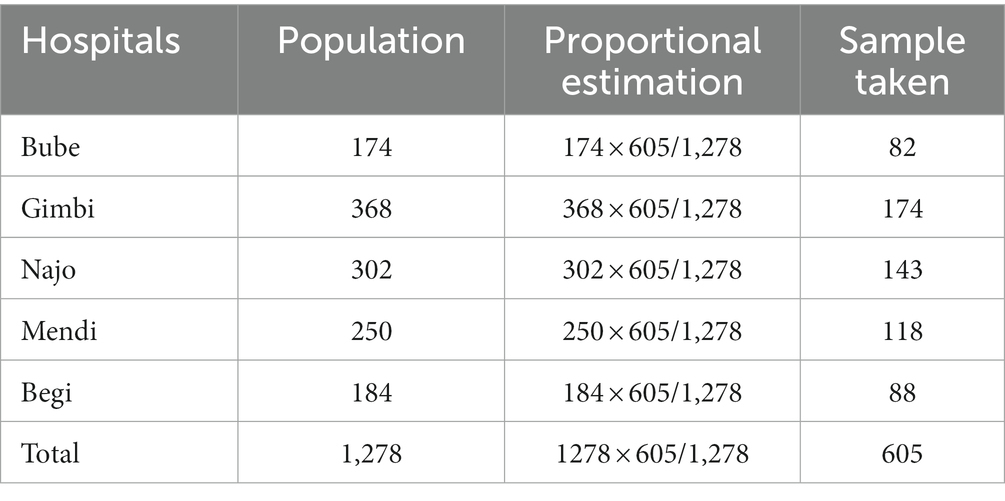
Table 1. Proportional allocation of the study population to the respective public hospitals in the West Wollega Zone, Oromia Region, Ethiopia in the year 2022 (n = 605).
The sample of 605 participants was obtained by proportionally allocating those five hospitals by considering their monthly delivery flows for one quarter. Consequently, study subjects were recruited by a systematic random sampling technique at every K interval of 2 (K=N/n = 1278/605 = 2), so every woman who gave birth in the hospital was recruited as a study subject in each hospital until the total sample size for this study was obtained (Figure 2).
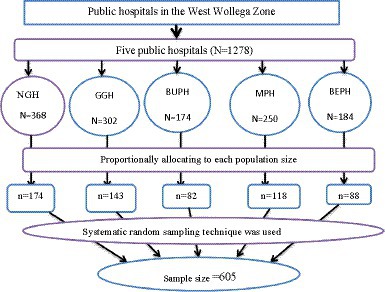
Figure 2. Schematic representation of systematic random sampling techniques for the study that was conducted in public hospitals in the West Wollega zone, Oromia, Ethiopia in the year 2022. BPH, Begi Primary Hospital; NGH, Nejo General Hospital; MPH, Mendi Primary Hospital; GGH, Gimbi General Hospital; BPH, Bube Primary Hospital.
Study variables
Immediate postpartum intrauterine device utilization is the dependent variable and the independent variables are as follows: sociodemographic characteristics: age of the mother, marital status, educational status of women, husband’s educational status, occupation of mothers, husband’s occupation, mother’s residential area, with whom mothers live, family size, and distance from hospitals; reproductive health history of mothers on IPPIUD: age at marriage, age at first delivery, number of pregnancies, number of deliveries, whether current pregnancy was planned, number of births, delivery pregnancy, current birth outcome, weeks at ANC initiation, number of ANC follow-ups, number of alive children, desire for future children, and place of delivery; knowledge of mothers on IPPUCD: prevents pregnancy for more than 10 years, can be inserted immediately after delivery, used by breastfeeding mothers, causes changes in the menstrual bleeding pattern, does not cause cancer, and can be removed at any time; the attitude of mothers on PPIUD: invades privacy during insertion, restricts normal activity, causes damage to the uterus, feeling of moving through the body after insertion, causes severe pain during insertion and removal, feeling of interference during sexual intercourse, and impairing future fertility.
Measurements and operational definitions
Utilization of IPPIUCD
Women who gave their verbal consent to use and who already had inserted in them the intrauterine device after the post-placental period within 10 min to 48 h of delivery (4, 5).
Knowledge of mothers on IPPIUCD
Women were asked 10 knowledge questions about the utilization of IPPIUCD and the correct response was scored 1 and the incorrect one was scored 0. After computing the sum score for each respondent, the mean score was calculated, and those who scored greater than the mean were considered as having “adequate knowledge” and those who scored below the mean as having “inadequate knowledge” about the utilization of IPPIUCD (19, 28, 32).
Attitude toward IPPIUCD
Eight questions were asked to assess the attitude of women in IPPIUCD using the Likert Scale (1 = strongly disagree, 2 = disagree, 3 = neutral, 4 = agree, and 5 = strongly agree). After computing the sum score for each respondent, the mean score was calculated and those who scored above the mean were considered as having a “favorable attitude” and those who scored below the mean as having an “unfavorable attitude” toward the utilization of IPPIUCD (28, 32).
Data collection tool and procedures
Data were collected through face-to-face interviews using structured questionnaires that were adapted by reviewing different literatures (4, 5, 22, 33). The questionnaire was prepared in English and translated to Afan Oromo by a language expert to better understand both the data collectors and the respondents and then translated back to the English version to check the consistency. A reliability coefficient (Cronbach’s alpha) was calculated for Likert scale questions in SPSS, which is α = 0.914. The questionnaire has the following parts such as sociodemographic characteristics, reproductive and obstetric characteristics, knowledge of family planning and immediate postpartum intrauterine devices, the attitude of the mother toward IPPIUD, and utilization of immediate postpartum intrauterine devices.
The supervisors together with data collectors were assigned to each hospital. The data collectors were asked to fill out the questionnaires between immediately after delivery of the placenta and within 48 h of the postpartum period and submit them when they were finished. The supervisors organized the filled questionnaires from data collectors and submitted them to the principal investigator each day. Two diploma and three BSc midwives were recruited as data collectors and two BSc midwives as supervisors based on their language skills and supervision experience. There were familiarized with the study area and trained on the study objectives, the method of data collection, and the tools for data collection. Trained data collectors collected the data at all hospitals using a revised version of the data collection tool, and they interviewed the mothers who gave birth in any of the five study hospitals.
Data quality assurance
To ensure the quality of the data, a step-by-step process was applied to minimize bias and errors during the study design, sampling, questionnaire development, data collection, and data processing. To ensure data quality, the data collection tool was developed in English, translated to the local language, Afan Oromo, and then translated back to English by a language expert (an individual who has good knowledge of both English and Afan Oromo languages) to ensure its consistency. A pretest of the questionnaire was conducted at Danbidollo Hospital, which is not included in the study, by taking 5% of the total sample size (30 participants) to assess the consistency and accuracy of the tool. After the pretest of the tools, the necessary modifications were made to the questionnaires before use for actual data collection.
Data collectors and supervisors were given a 2-day training on the study objectives, the method of data collection, and the tools for data collection. During data collection, the data collectors were supervised regularly, and necessary feedback was given. Information was checked for completeness and internal consistency before and during the data processing phase. Incomplete data were discarded. Questionnaires were checked to ensure all data had been filled in to avoid missing data. The investigator checked for the completeness and consistency of questionnaires filled out by the data collectors to ensure the quality of the data.
Data processing and analysis
Filled-in questionnaires were checked for completeness and consistency. The data was coded and entered into Epi-data version 4.6 before being exported to SPSS version 26 for cleaning and analysis. After the gathered data were checked for missing values, outliers, and fulfillment of assumptions, the variables were computed and recoded by the transform function of SPSS. Descriptive statistics were summarized using frequencies, percentages, mean, standard deviation, and interquartile range and were presented in the form of figures, tables, and text.
A bivariable analysis was conducted for all independent variables against each dependent variable separately using binary logistic regression to see their association. Variables that showed a significant association in the bivariable analysis with a p-value of ≤ 0.25 and 95% CI were candidates for multivariable logistic regression and were entered into multiple logistic regression to identify their independent effects. A multivariable logistic regression analysis was conducted after checking the model fitness test using the Hosmer-Lemeshow goodness-of-fit test. The p-value of the Hosmer-Lemeshow goodness-of-fit test of the model was checked, and it was well fitted with p = 0.867, and the omnibus test was significant, and the assumption was fulfilled since the p-value was greater than 0.05.
Multicollinearity was also checked by standard error for the β-coefficient (a standard error > 2 indicates its presence as a cutoff point), and the backward logistic regression selection method was used to identify the variable remaining for the final. The variables with a p-value of ≤ 0.05 with a respective adjusted odds ratio (AOR) and 95% CIs were used to declare the significantly associated factors with immediate postpartum intrauterine device utilization.
Results
Sociodemographic characteristics of study respondents
A total of 599 respondents were interviewed with a response rate of 99% since six participants were not included in the study as a result of non-responses during data collection. The mean and standard deviation of the respondent’s age was 27.49 (6.51) years. Of the study respondents, 292 (48.7%) were in the age range of 25–34 years, 130 (21.9%) in the age range of 15–24 years, and 167 (29.4%) in the age range of 34–49 years. Out of the study respondents, the largest proportion, 544 (90.8%), were married. Of the study respondents, 135 (22.5%) had a college degree and above. Regarding the occupational status of women and their husbands, 315 (52.6%) and 193 (32.8%) were homemakers and farmers, respectively. The majority of the study respondents, i.e., 537 (89.6), were living with their husbands. Almost half of the study respondents, 305 (50.9%), were living in urban areas (Table 2).
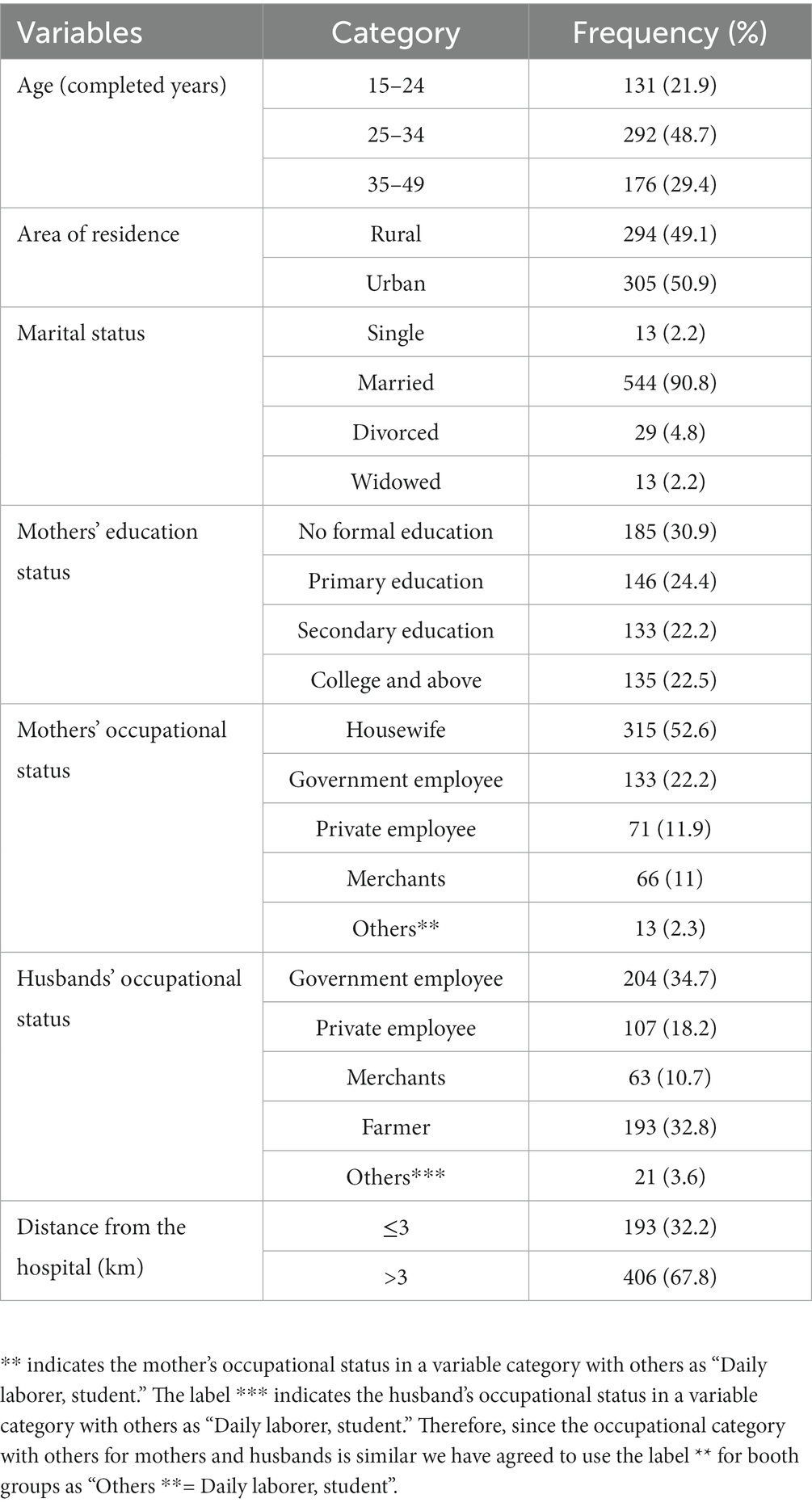
Table 2. Sociodemographic characteristics of women who gave birth in public hospitals of West Wollega Zone in the year 2022 (n = 599).
Reproductive characteristics of the study respondents
The mean and standard deviation of marriage age were 19.28 (2.58) years. Four hundred eighty-two (81.7%) had married at an age greater than or equal to 18 years. The of age 566 (94.5%) mothers at first delivery was 18 years or above. Two hundred eighty-six (54.6%) women had given birth two to four times, and 53 (8.8%) women had given birth five or more times. The mean (SD) number of alive and wanted children in life was 2.46 (1.76) and 4.14 (1.57), respectively. Five hundred twenty-seven (88.0%) mothers had antenatal care follow-up for their then-current pregnancy. One hundred thirty-nine (23.2%) had initiated antenatal care services at less than or equal to 16 weeks for their then-current pregnancy. Four hundred ninety-four (82.5%) mothers had used family planning before this pregnancy. Two hundred thirty-eighty (45.2%) and two hundred fifty-eight (49%) women had made 2–3 and 4 and above ANC visits, respectively. Most mothers, 430 (71.8%), had discussed family planning with their husbands. Approximately 543 (90.7%) women responded that both husbands and wife had decided on the number of children they wanted to have together (Table 3).
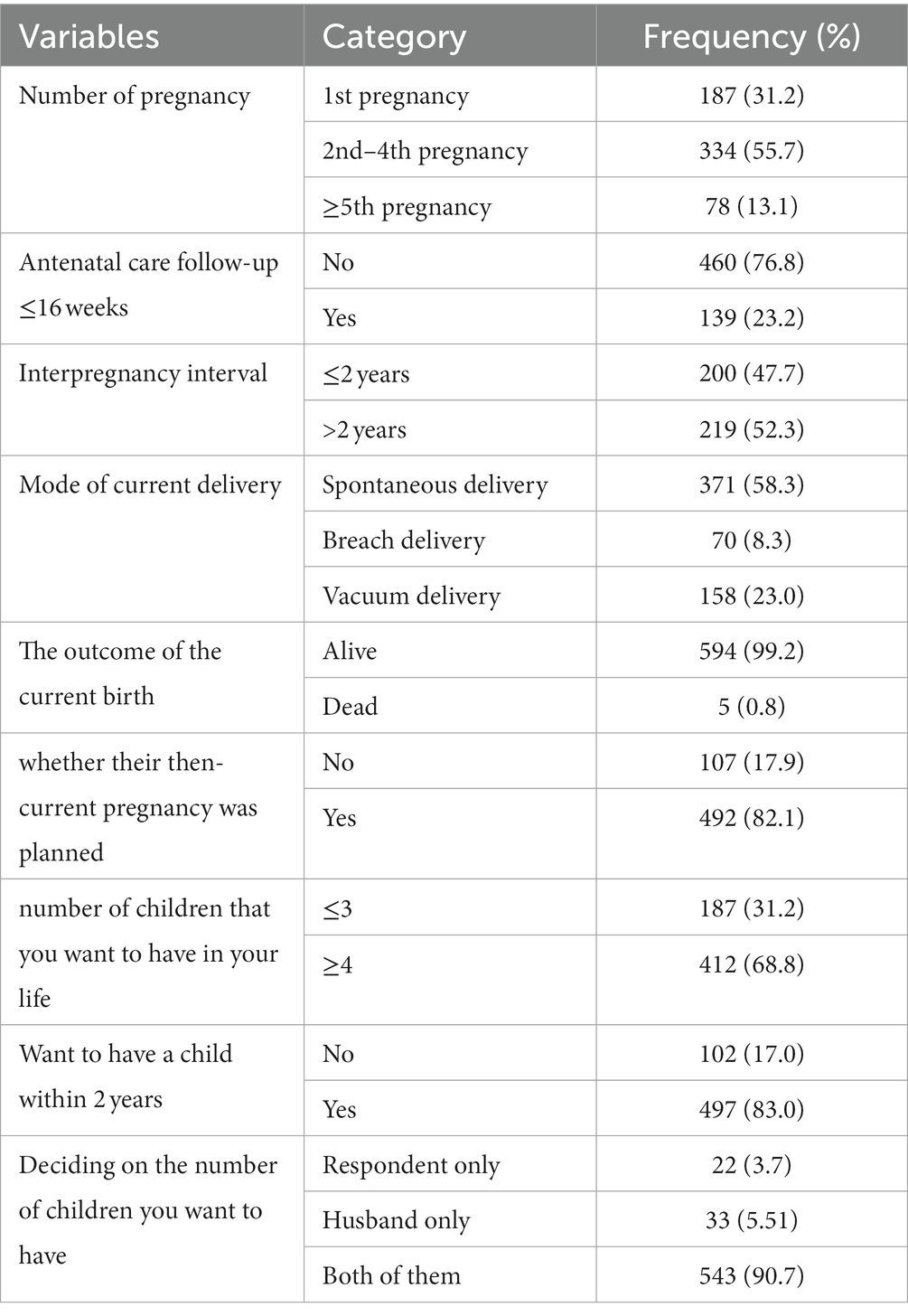
Table 3. Reproductive characteristics of mothers who gave birth in public hospitals of West Wollega Zone, Oromia, Ethiopia (n = 599).
Family planning and types of family planning used before this pregnancy by the mothers
A total of 494 respondents (82.5%) had used the family planning method before their then-current birth. The majority of mothers (38.7%) had used injectable contraceptives (Figure 3).

Figure 3. Types of family planning used by respondents before their then-current pregnancy in public hospitals in West Wollega Zone in the year 2022. * Condoms and emergency pills.
Knowledge of mothers on immediate postpartum intrauterine device
The mean score of the knowledge status of the respondents was 4.32 (±3.35 SD). The study reported that 316 (52.8%) respondents had inadequate knowledge and 283 (47.2%) had adequate knowledge of immediate postpartum intrauterine devices. In total, 252 (58.8%) participants knew that an IUD can prevent pregnancies for more than 10 years, 234 (39.1%) participants knew that an IUD can be inserted immediately after delivery, 259 (43.2%) knew that an IUD is immediately reversible; and 202 (33.7%) knew that an IUD does not cause cancer (Table 4).
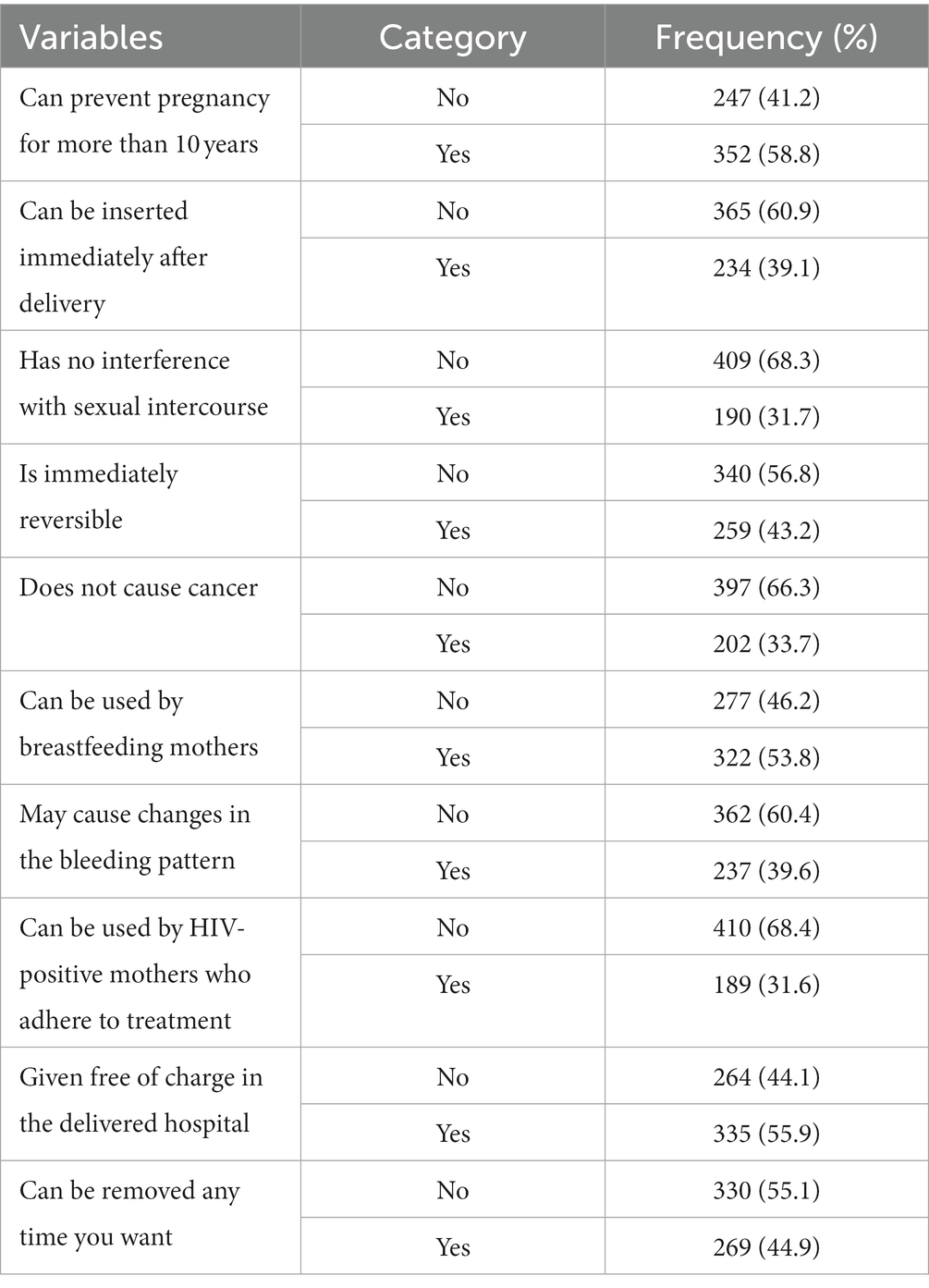
Table 4. Knowledge of the respondents on immediate postpartum intrauterine device utilization among mothers who gave birth in public hospitals in West Wollega Zone, Oromia, Ethiopia in the year 2022 (n = 599).
Mother’s attitude toward IPPIUD utilization
The mean score (±SD) value of the participant’s attitude toward the immediate PPIUD utilization were 20.79 (SD ± 6.65). Using the sum score as the cutoff point, the study showed that 184 (30.7%) mothers had a favorable attitude toward the utilization of immediate postpartum intrauterine devices. In total, 199 (33.2%) mothers disagreed that IUD insertion inside the uterus does not lead to a loss of privacy, while 38 (6.3%) strongly agreed to the loss of privacy. Two hundred fifteen (35.9%) participants agreed that using IPPIUD does not restrict normal activities. Additionally, 192 (32.1%) agreed that IPPIUD does not move through the body after insertion and 259 (26.5%) agreed and 96 (16%) highly agreed that IPPIUD does not interfere with sexual intercourse. Also, 88 (14.7%) participants highly disagreed with IPPIUD’s ability to harm a woman’s uterus (Table 5).
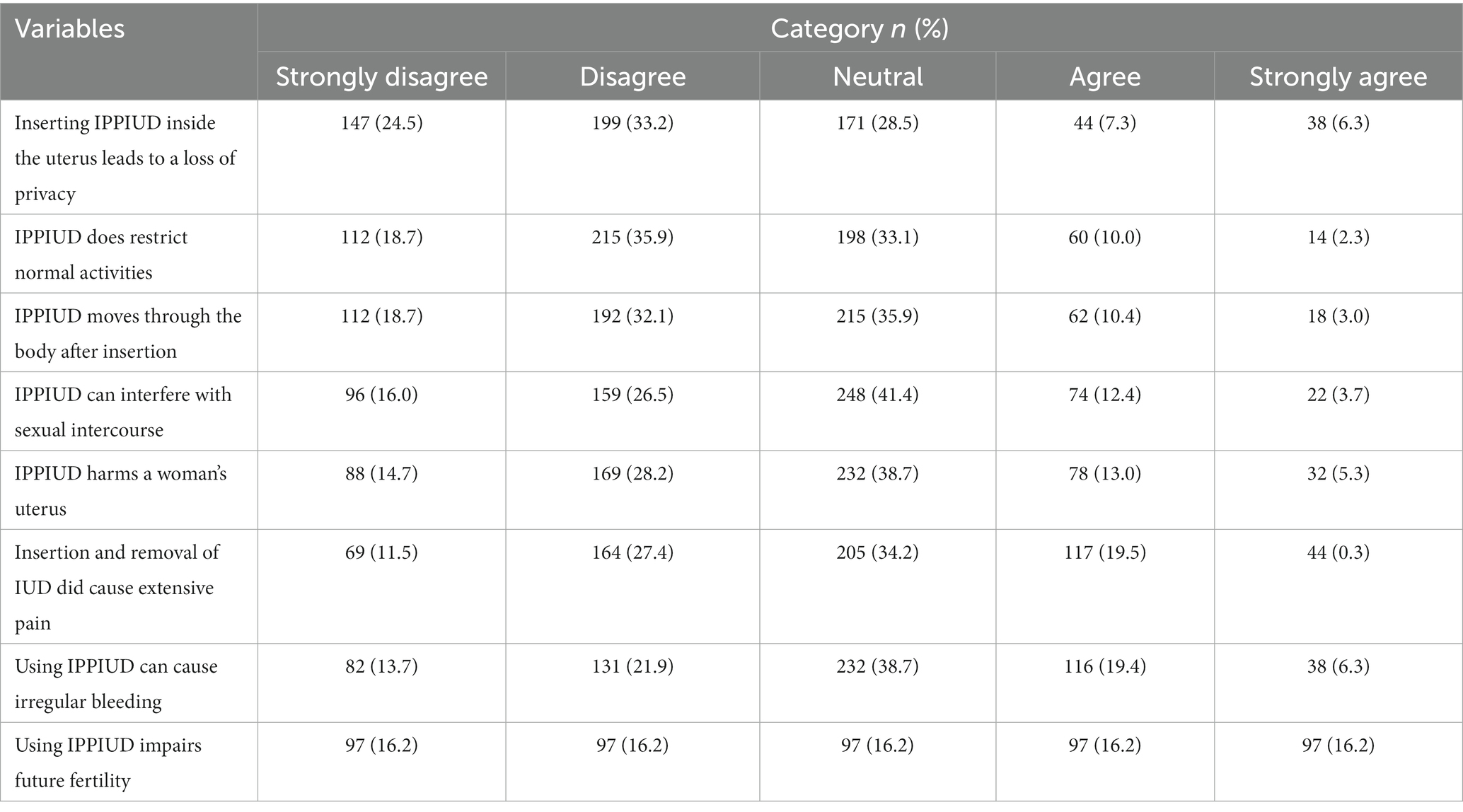
Table 5. Attitude of the mothers toward immediate postpartum intrauterine device utilization among women who gave birth in public hospitals in West Wollega Zone, Oromia, Ethiopia in the year 2022 (n = 599).
Immediate postpartum intrauterine device utilization and the reasons for utilization
The study showed that the prevalence of utilization of immediate postpartum intrauterine devices was 27.2% (95%CI: 23.7–30.9). A total of 111 (52.6%) respondents were counseled for immediate postpartum intrauterine devices. During ANC visits, 53 (32.5%) and 44 (27.0%) mothers had information about immediate postpartum IUD and needed a long-acting, safe, and effective method to use the immediate postpartum IUD, respectively (Table 6).

Table 6. Reasons for immediate postpartum intrauterine device utilization among mothers who gave birth in public hospitals in West Wollega Zone, Oromia, Ethiopia in the year 2022.
The reasons for respondents not utilizing an immediate postpartum intrauterine device
The most common reasons mentioned by study respondents to not utilize an immediate postpartum intrauterine device were a lack of awareness for 204 (34.2%) respondents followed by a fear of side effects for 125 (20.9%) respondents (Figure 4).
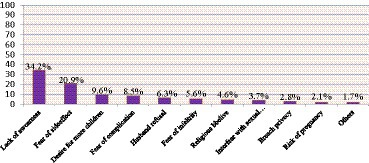
Figure 4. The reasons respondents did not utilize immediate postpartum intrauterine devices among women who gave birth in public hospitals in West Wollega Zone, Oromia, Ethiopia in the year 2022. Others: peers or relatives.
Factors associated with immediate postpartum intrauterine device utilization
A binary logistic regression was performed to assess the association of each independent variable with immediate postpartum intrauterine device utilization. Of all the assessed factors, 14 variables showed association in the bivariable analysis: age of respondents; educational status of mothers; age at first delivery; antenatal care initiation at or less than 16 weeks; status of pregnancy (planned or not); family planning used before this birth; want to have a child within 2 years; knowledge status; ANC follow-up during current pregnancy; number of children you want to have in your life; discussing with their partner; attitude status; decided on the number of children you want to have; and counseled on immediate postpartum intrauterine device.
The variables with a p-value of less than 0.25 were entered into the multivariable logistic regression model after controlling for confounders. The results of the multivariable logistic regression model revealed that age of the respondents, antenatal care initiation at or less than 16 weeks, mothers whose current pregnancy is planned, adequate knowledge of immediate postpartum intrauterine devices, favorable attitude, and mothers who had been counseled on IPPIUD were found to be significantly associated with immediate postpartum intrauterine device utilization at a p-value of ≤ 0.05 together with 95% confidence intervals.
According to this study, age of the respondents were associated with immediate postpartum intrauterine device utilization: Mothers in the age groups of 25–34 years (AOR = 2.45, 95% CIs: 1.32–4.89) and 35–49 years (AOR = 1.37, 95% CIs: 1.02–2.81) were 2.45 times and 1.37 times more likely to utilize IPPIUD as compared to those in the age group of 15–24 years, respectively.
The study revealed that antenatal care initiation at or less than 16 weeks was significantly associated with immediate postpartum intrauterine device utilization. The mothers who had started antenatal care visits at an early gestational age were almost two times more likely to utilize IPPIUD than those who started later (AOR = 2.25, 95% CIs: 1.35–3.76). The results of the study revealed that those mothers whose current pregnancy was planned were two times more likely to use immediate postpartum intrauterine devices than mothers whose current pregnancy was unplanned (AOR = 2.21, 95%CIs: 1.37–4.11).
The study showed that mothers who had adequate knowledge of immediate postpartum intrauterine devices after delivery were 4.71 times more likely to use them than their counterparts (AOR = 4.71, 95% CIs: 2.63–6.63). Mothers who had favorable attitudes were three times more likely to utilize immediate postpartum intrauterine devices than mothers who had unfavorable attitudes (AOR = 3.35, 95% CIs: 2.07–5.44). Mothers who had been counseled on IPPIUD were four times more likely to utilize IPPIUD than those who had not been counseled (AOR = 4.14, 95% CIs: 2.60–6.68) (Table 7).
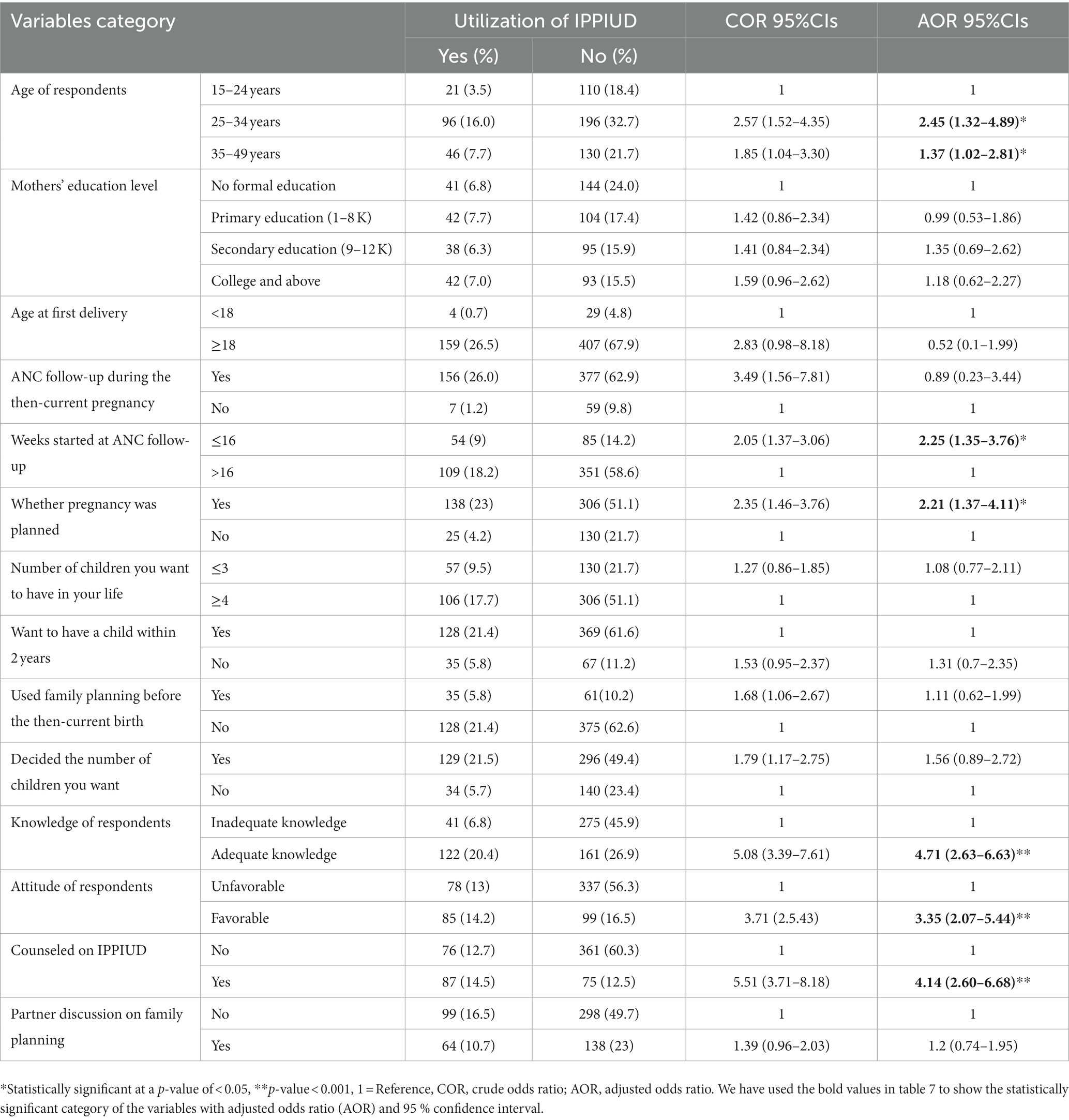
Table 7. Factors associated with immediate postpartum intrauterine device utilization among mothers who gave birth in hospitals in West Wollega zone, Oromia, West Ethiopia, 2022 (n = 599).
Discussion
This study aimed to assess the prevalence of immediate postpartum intrauterine contraceptive device utilization and identify factors that affect its utilization. The prevalence of immediate postpartum intrauterine contraceptive device utilization within 48 h of delivery was 27.2% (95% CIs: 23.5–30.7). This finding was in line with the studies conducted in public hospitals in Addis Ababa with a prevalence of 26.6% (3), Debre Berhan of 25.4% (5), Gondar of 48.4%, northwest Ethiopia (8), and Bahir Dar of 44% (34) and public health facilities in Gamo Zone of 26.4% (35).
The possible reasons for this similarity might be the level of awareness, early initiation of antenatal care of respondents, adequate knowledge of, and favorable attitude toward IPPIUD in the study areas (31). This finding was also in line with the studies conducted in Rwanda, Malaya of Cameroon, and India with the prevalence of 28.1% (30), 28.4% (16), and 28.33% (10). The possible reason for this similarity might be that women who utilized IPPIUD discuss with unutilized women its utilization benefits, the procedures, and the time taken, which might decrease the fear of women toward IPPIUD utilization.
The finding of the present study regarding the prevalence of IPPIUD utilization was higher than the studies conducted in Bale Zone (12.4%) (17); in Jimma University Medical Center (10.5%) (33); in Dessie Town (7%) (34); in Adama and Olenchiti (12.4 and 4.8% in the intervention and non-intervention groups, respectively) (11); at Saint Paul’s Millennium Medical College (7.8%) (23); and in Sidama Zone, south Ethiopia (21.9%) (4). These variations might be attributed to sociodemographic characteristics of the participants among study areas; differences in samples; time differences; misconceptions about intrauterine devices in the study areas; and to the existence of healthcare provider training and material support from a non-governmental organization in the study area.
The result of this finding was lower than found in a study conducted in Arsi Negele, which found that approximately 33.5% of study respondents had utilized IPPIUD (36), and a study conducted in Gamo Zone, southern Ethiopia, which found 35.6% of them had utilized IPPIUD (35). This inconsistency may be due to differences in the study design, sample size, and improvement of the health facilities on service provision of family planning with time. This result of this finding is also lower than that found in a study conducted in central India in a tertiary care center, in which it was reported that 36% of respondents had utilized IPPIUD (37), a study conducted in Minnesota on Somali immigrants, in which 39.7% of them had utilized IPPIUD (15), and a study conducted in Tanzania, in which 31.6% of them had utilized IPPIUD (38). These variations of immediate postpartum intrauterine device utilization might be attributed to sociodemographic characteristics variations due to the difference in the level of awareness and educational status of respondents, the difference in a sample, cultural beliefs, unfavorable attitudes, and misconceptions about intrauterine devices in the study areas (31, 35).
According to this study, those mothers in age category of 25–34 years and 34–49 years were more likely to utilize immediate postpartum intrauterine device compared to those within the age group of 15–24 years. The result of the finding is consistent with a study conducted in Gondar, Northwest Ethiopia (8). This might be due to older women being more willing to utilize immediate postpartum intrauterine devices than younger women since the age of the women is associated with increased awareness and understanding. It is well recognized that age plays an important role in women’s utilization of immediate postpartum intrauterine device and that maternal age may sometimes serve as a proxy for an accumulated understanding of long-acting family planning services (6). Age may be the factor that may have a positive influence on the accepting of IPPIUD utilization among women.
However, this finding was inconsistent with the study conducted in Debra Tabor (25) and Ambo Town, western Ethiopia (39). This inconsistency may be due to variations in respondents’ sociodemographic characteristics of the study area; the time gap between the study and sample size; the difference in awareness of intrauterine devices; the educational status of the study respondents; various misconceptions about IPPIUD in the study areas; differences in the study design; and variations in the health facilities’ provision of family planning services over time.
The results of this study revealed that those mothers who had planned their pregnancy were more likely to utilize immediate postpartum intrauterine devices than those mothers who had not planned their pregnancy. This finding is consistent with studies conducted in the Gamo Zone, southern Ethiopia (35); Debre Berhan, Ethiopia (5); and Addis Ababa, Ethiopia (23). This could be due to mothers’ understanding and attitude on timing and spacing of births by having a planned pregnancy through the utilization of immediate postpartum intrauterine devices after delivery.
The study also found that those mothers who had adequate knowledge of immediate postpartum intrauterine devices immediately after delivery were more likely to utilize IPPUD than their counterparts. This finding is consistent with studies conducted in Nigeria (40) and Rwanda (30), in Nepal (14), and in Durban, South Africa (28). The possible explanation for this finding is that as mothers get information on immediate postpartum intrauterine device utilization, their awareness of IUDs increases and their acceptance of the immediate postpartum intrauterine device improves.
The mothers who had favorable attitudes toward IPPIUD were more likely to utilize immediate postpartum intrauterine device than those mothers who had unfavorable attitudes. The current finding is in line with the studies conducted in Debre Berhan Town (5), Nigeria (40), and Tanzania (38). This may be due to women who have a favorable attitude toward immediate postpartum intrauterine device utilization having the self-initiative to know about the advantages and disadvantages of these devices.
The result of this study revealed that those mothers who were counseled on IPPIUD were more likely to utilize IPPIUD than those who had not been counseled. The study is consistent with a study conducted in Han Health Center, Bahir Dar, Ethiopia (6), a study conducted in Debre Berhan, Ethiopia (5), a study conducted in Kebri Beyan, Somali Region (25), and a study conducted in Jima University Medical Xenter (33) and a study conducted in the Sidama Zone (4). The possible explanation for this finding is that as mothers get counseling on immediate postpartum intrauterine device utilization at maternal, neonatal, and child health points of contact within the health system, their awareness about the importance of IUDs would be improved.
Strengths and limitations of the study
Only those women who gave a birth at all five public hospitals that provides IPPIUD service in the West Wollega Zone were included in this study. As a limitation, social desirability bias may occur due to the interview time of the questions, i.e., immediate after delivery, on some variables during data collection, and since the study was conducted in public hospitals; women who gave birth at health centers, private health facilities, and at home were not included in the study, which is another limitation.
Conclusion
Immediate postpartum intrauterine device utilization was low when compared to the national targets of Ethiopia predicted during the mini EDHS 2019, which was 35% (41). Age of respondents, initiation of antenatal care at or less than 16 weeks, pregnancy status of women as planned or not, knowledge status, attitude status, and counseling on the immediate postpartum intrauterine device were significantly associated with mothers’ utilization of the immediate postpartum intrauterine device.
Recommendation
Health professionals should work toward encouraging all the women who gave birth at public hospitals to utilize an immediate postpartum intrauterine device through the integration of its services in routine maternal, neonatal, and child health service areas to increase the uptake of IPPIUD. Pregnant women should be given awareness about IPPIUD through counseling during their ANC appointments to provide them with a long-acting, safe, and effective protection against unwanted pregnancy, especially younger women. Furthermore, improving the knowledge and attitude of pregnant women toward IPPIUD utilization starting from ANC visit initiation to delivery is recommended to increase the prevalence of IPPIUD utilization.
Data availability statement
The original contributions presented in the study are included in the article/supplementary material, further inquiries can be directed to the corresponding author.
Ethics statement
Ethical approval was obtained from the ethical review committee of College of Health Science, Salale University, Fiche, Ethiopia. Permission letters were obtained from all public hospitals before conducting data collection, and the gathered data were secured at all levels. The data collectors explained the objective of the study to ensure the willingness of the study participants before filling in the questionnaire and informed the participants on the confidentiality of any information they provide. Informed written consent was obtained from each respondent after explaining the purpose and procedures. Considering the sensitivity of this research, all basic principles of human research ethics (respect of persons, beneficence, voluntary participation, confidentiality, and justice) have been secured.
Author contributions
AHG, EBK, and TN participated in conceptualization, data curation, formal analysis, investigation, funding acquisition, methodology, project administration, resources, software, supervision, validation, visualization, writing original draft, writing review, and editing the manuscript. DG and DBS were involved in data curation, methodology, resources, analysis, investigation, supervision, validation, writing review, and editing the manuscript. All authors contributed to the article and approved the submitted version.
Funding
The financial fund was covered by Salale University on behalf of Oromia Health Bureau (OHB) sponsorship.
Acknowledgments
We would like to thank Salale University for giving us the chance to conduct this research activity and providing all the necessary support. We would like to extend our thanks to the data collectors, supervisors, and study participants. Last but not least, we acknowledge West Wollega Zone health office and all public hospitals for providing us with all important basic data and required information.
Conflict of interest
The authors declare that the research was conducted in the absence of any commercial or financial relationships that could be construed as a potential conflict of interest.
Publisher’s note
All claims expressed in this article are solely those of the authors and do not necessarily represent those of their affiliated organizations, or those of the publisher, the editors and the reviewers. Any product that may be evaluated in this article, or claim that may be made by its manufacturer, is not guaranteed or endorsed by the publisher.
References
1. Daba, G, Deressa, JT, and Sinishaw, W. Assessment of intention to use postpartum intra uterine contraceptive device and associated factors among pregnant women, West Shoa Zone, Ethiopia. Contracept Reprod Med. (2018) 2018:1–18. doi: 10.1186/s40834-021-00152-x
2. John, W, et al. Family Planning Managers Hand Book. HRH Global Resource Center: Management Sciences for Health. (1991). 1–30.
3. Geda, YF, Nejaga, SM, Belete, MA, Lemlem, SB, and Adamu, AF. Immediate postpartum intrauterine contraceptive device utilization and influencing factors in Addis Ababa public hospitals: a cross-sectional study. Contracept Reprod Med Res. (2021) 6:1–10. doi: 10.1186/s40834-021-00148-7
4. Tefera, LB, Abera, M, Fikru, C, and Tesfaye, DJ. Utilization of immediate post-partum intra uterine contraceptive device and associated factors: a facility based cross sectional study among mothers delivered at public health facilities of Sidama Zone, South Ethiopia. J Preg Child Health. (2017) 4:326. doi: 10.4172/2376-127X.1000326
5. Demie, TG, Demissew, T, Huluka, TK, Workineh, D, and Libanos, HG. Postpartum family planning utilization among postpartum women in public health institutions of Debre Berhan Town, Ethiopia. J Women’s Heal Care. (2018) 7:2. doi: 10.4172/2167-0420.1000426
6. Animen, S, Lake, S, and Mekuriaw, E. Utilization of intra uterine contraceptive device and associated factors among reproductive age group of family planning users in Han Health Center, Bahir Dar, North West Amhara, Ethiopia, 2018. BMC Res Notes [Internet]. (2018) 11:922. doi: 10.1186/s13104-018-4032-z
7. Glasier, A, Baird, D, Blumenthal, P, Cameron, S, Fiander, A, Gebbie, A, et al. Best practice in postpartum family planning. Int J Sci Study. (2015) 1:2–4.
8. Abera, Y, Mengesha, ZB, and Tessema, GA. Postpartum contraceptive use in Gondar town, Northwest Ethiopia: A community based cross-sectional study. BMC Womens Health. (2015) 15:1–8. doi: 10.1186/s12905-015-0178-1
9. Microfinance and rural women’s empowerment. Annual Report Annual Report [Internet]. Nekemte: Mares (2016) Available at: https://www.pvh.com/-/media/Files/pvh/investor-relations/PVH-Annual-Report-2020.pdf.
10. Da Costa, V, Ingabire, R, Sinabamenye, R, Karita, E, Umutoni, V, Hoagland, A, et al. An exploratory analysis of factors associated with interest in postpartum intrauterine device uptake among pregnant women and couples in Kigali. Rwanda Clin Med Insights Reprod Heal. (2019) 13:117955811988684. doi: 10.1177/1179558119886843
11. Befkene Wayessa, M, Workineh Abebe, T, Mannekulih Habtewold, E, Megerso Adilo, A, Teklu Meressa, A, Garoma Abaya, S, et al. Focused family planning counseling increases immediate postpartum intrauterine contraceptive device uptake: a quasi-experimental study. Open Access J Contracept. (2020) 11:91–102. doi: 10.2147/OAJC.S246341
12. United Nations Department of Economic and Social Affairs (UN DESA). World Family Planning. Highlights health Key findings. United Nations [Internet]. (2020) 2020:2. Available at: https://www.un.org/development/desa/pd/
13. World Health Organization (WHO). Family Planning, a Global Handbook for providers. World Health Organization. (2018).
14. Pradhan, E, Canning, D, Shah, IH, Puri, M, Pearson, E, Thapa, K, et al. Integrating postpartum contraceptive counseling and IUD insertion services into maternity care in Nepal: Results from stepped-wedge randomized controlled trial. Reprod Health. (2019) 16:1–15. doi: 10.1186/s12978-019-0738-1
15. Millar, A, Vogel, RI, Bedell, S, Looby, MA, Hubbs, JL, Harlow, BL, et al. Patterns of postpartum contraceptive use among Somali immigrant women living in Minnesota. Contracept Reprod Med. (2017) 2:1–7. doi: 10.1186/s40834-017-0041-x
16. Tolefac, PN, Nana, TN, Yeika, EV, Awungafac, NS, Ntsama, Y, and Njotang, PN. Trends and patterns of family planning methods used among women attending family planning clinic in a rural setting in sub-Sahara Africa: The case of Mbalmayo District Hospital, Cameroon. BMC Res Notes. (2018) 11:10–4. doi: 10.1186/s13104-018-3658-1
17. Gonie, A, Worku, C, Assefa, T, Bogale, D, and Girma, A. Acceptability and factors associated with post-partum IUCD use among women who gave birth at bale zone health facilities, Southeast-Ethiopia. Contracept Reprod Med. (2018) 3:1–8. doi: 10.1186/s40834-018-0071-z
18. WHO, UNICEF U. Ethiopia basic emergency obstetric. Fed Democr Repub Ethiop Minist Heal. (2016) 11:28–40.
19. Assefaw, M, Azanew, G, Engida, A, Tefera, Z, and Gashaw, W. Determinants of postpartum intrauterine contraceptive device uptake among women delivering in public hospitals of South Gondar Zone, Northwest Ethiopia, 2019: an unmatched case-control study. Obstet Gynecol Int. (2021) 2021:1–11. doi: 10.1155/2021/1757401
20. Ethiopian Federal Ministry of Health. Opportunities for family planning programming in the postpartum period in India. FMOH [Internet]. (2020):2–3. Available at: https://track20.org/download/pdf/PPFP%20Opportunity%20Briefs/english/India%20PPFP%20Opportunity%20Brief%202.pdf
21. World Health Organization (WHO), UNICEF, UNFPA WB. Trends in maternal mortality 2010 - 2015, WHO. World Heal Organ [Internet]. (2015):92. Available at: http://www.who.int/reproductivehealth/publications/monitoring/maternal-mortality2015
22. Mihretie, GN, Simegn, A, Dereje, A, Gebrehana, H, Getie, A, Getnet, B, et al. Postpartum modern contraceptive utilization and associated factors among women who gave birth in the last 12 months in addis zemen, south gondar, ethiopia: Community-based cross-sectional study. Int J Women's Health. (2020) 12:1241–51. doi: 10.2147/IJWH.S282733
23. Belay, L, and Birara, M. Factors affecting long-term and permanent contraceptive uptake among post-partum mothers at a hospital in Addis Ababa, Ethiopia: a cross-sectional study. Lancet Glob Heal. (2018) 6:S34. doi: 10.1016/S2214-109X(18)30163-3
24. Abadiga, M, Wakuma, B, Oluma, A, Fekadu, G, Hiko, N, and Mosisa, G. Determinants of preterm birth among women delivered in public hospitals of Western Ethiopia, 2020: Unmatched case-control study. PLoS One. (2021) 16:e0245825. doi: 10.1371/journal.pone.0245825
25. Taye, EB, Mekonen, DG, and Debele, TZ. Prevalence of post partum modern family planning utilization and associated factors among postpartum mothers in Debre Tabor town, North West Ethiopia, 2018. BMC Res Notes. (2019) 12:1–7. doi: 10.1186/s13104-019-4464-0
26. Mulatu, T, Sintayehu, Y, Dessie, Y, and Deressa, M. Modern family planning utilization and its associated factors among currently married women in rural Eastern Ethiopia: a community-based study. Hindawi BioMed. (2020) 2020:1–9. doi: 10.1155/2020/6096280
27. Embafrash, G, and Mekonnen, W. Level and correlates of unmet need of contraception among women in extended postpartum in Northern Ethiopia. Int J Reprod Med. (2019) 2019:1–9. doi: 10.1155/2019/6351478
28. Monji Builu, P, and Naidoo, TD. Attitudes towards and knowledge about intrauterine contraceptive devices among women in the reproductive age group in a resource-constrained setting. S Afr J Obstet Gynaecol. (2015) 21:27–32. doi: 10.7196/sajog.950
29. Hounton, S, Winfrey, W, Barros, AJD, and Askew, I. Patterns and trends of postpartum family planning in Ethiopia, Malawi, and Nigeria: Evidence of missed opportunities for integration. Glob Health Action. (2015) 8:29738. doi: 10.3402/gha.v8.29738
30. Kanakuze, CA, Kaye, DK, Musabirema, P, Nkubito, P, and Mbalinda, SN. Factors associated with the uptake of immediate postpartum intrauterine contraceptive devices (PPIUCD) in Rwanda: a mixed methods study. BMC Pregnancy Childbirth. (2020) 20:1–15. doi: 10.1186/s12884-020-03337-5
31. Gebremedhin, M, Alemayehu, A, Yihune, M, Melis, T, Fikadu, Y, Arja, A, et al. Utilization of immediate postpartum intrauterine contraceptive device and associated factors among women who gave birth at government hospitals of Gamo Zone, Southern Ethiopia, 2019. Austin J Preg Child Birth. (2021) 2:1–7
32. Gupta, N, Sinha, R, and Mangal, A. Knowledge, attitude and practice study on immediate postpartum intrauterine contraceptive device method of family planning. Int J Commu Med Public Heal. (2017) 4:2981. doi: 10.18203/2394-6040.ijcmph20173357
33. Arero, W, Teka, W, and Jarso, H. Prevalence, and pattern of LARC use in immediate postpartum Period at Jimma University Medical Center, Ethiopia [18F]. Obstet Gynecol. (2018) 131:68S–S. doi: 10.1097/01.AOG.0000533328.55352.1b
34. Masresha Tegegn, MA, Arefaynie, M, and Tiruye, TY. Unmet need for modern contraceptives and associated factors among women in the extended postpartum period in Dessie town, Ethiopia. Contracept Reprod Med. (2017) 2:21. doi: 10.1186/s40834-017-0048-3
35. Jemal Mohammed, S, Gebretsadik, W, Endashaw, G, Shigaz Shimbre, M, Assfa Mossa, K, Nuriye Metebo, K, et al. Determinants of postpartum IUCD utilization among mothers who gave birth in gamo zone public health facilities, Southern Ethiopia: a case-control study. Open Access J Contracept. (2020) 11:125–33. doi: 10.2147/OAJC.S257762
36. Hibstu, DT, and Alemayehu, A. Long acting reversible contraceptives utilization and associated factors among women of reproductive age in Arsi Negele town, Southeastern Ethiopia. Contracept Reprod Med. (2020) 5:6. doi: 10.1186/s40834-020-00109-6
37. Jairaj, S, and Dayyala, S. A cross sectional study on acceptability and safety of IUCD among postpartum mothers at tertiary care hospital, Telangana. J Clin Diagnostic Res. (2016) 10:LC01–6. doi: 10.7860/JCDR/2016/16871.7020
38. Pearson, E, Senderowicz, L, Pradhan, E, Francis, J, Muganyizi, P, Shah, I, et al. Effect of a postpartum family planning intervention on postpartum intrauterine device counseling and choice: Evidence from a cluster-randomized trial in Tanzania. BMC Womens Health. (2020) 20:1–13. doi: 10.1186/s12905-020-00956-0
39. Tesfaye, J. assessment of intention to use postpartum intrauterine contraceptive device and associated factors among pregnant women attending antenatal clinics in ambo town public health institutions, Ethiopia, 2018. J Gynecol Womens Heal. (2020) 19:1–9. doi: 10.19080/JGWH.2020.19.556012
40. Bolarinwa, O. Principles and methods of validity and reliability testing of questionnaires used in social and health science researches. Niger Postgrad Med J. (2015) 22:195. doi: 10.4103/1117-1936.173959
41. Ethiopian Public Health Institute Addis Ababa. Ethiopia mini demographic and health survey. Federal Democratic Republic of Ethiopia. (2019):1–35.
Glossary
Keywords: intrauterine device utilization, postpartum family planning, post-partum intrauterine device, postpartum contraceptive, West Wollega Zone, Ethiopia
Citation: Guye AH, Kanea EB, Nigussie T, Girma D and Shambi DB (2023) Utilization of immediate postpartum intrauterine device and its associated factors among women who gave birth in public hospitals in West Wollega Zone, Oromia, Ethiopia. Front. Med. 10:1238496. doi: 10.3389/fmed.2023.1238496
Edited by:
Simcha Yagel, Hadassah Medical Center, IsraelReviewed by:
Xavier Espada-Trespalacios, Ramon Llull University, SpainMargarita Manresa, Hospital Clinic of Barcelona, Spain
Copyright © 2023 Guye, Kanea, Nigussie, Girma and Shambi. This is an open-access article distributed under the terms of the Creative Commons Attribution License (CC BY). The use, distribution or reproduction in other forums is permitted, provided the original author(s) and the copyright owner(s) are credited and that the original publication in this journal is cited, in accordance with accepted academic practice. No use, distribution or reproduction is permitted which does not comply with these terms.
*Correspondence: Ararso Hordofa Guye, YXJhcnNvLmhvcmRvZmFAeWFob28uY29t
 Ararso Hordofa Guye
Ararso Hordofa Guye Efa Bayissa Kanea
Efa Bayissa Kanea Tadesse Nigussie
Tadesse Nigussie Derara Girma
Derara Girma Dame Banti Shambi
Dame Banti Shambi